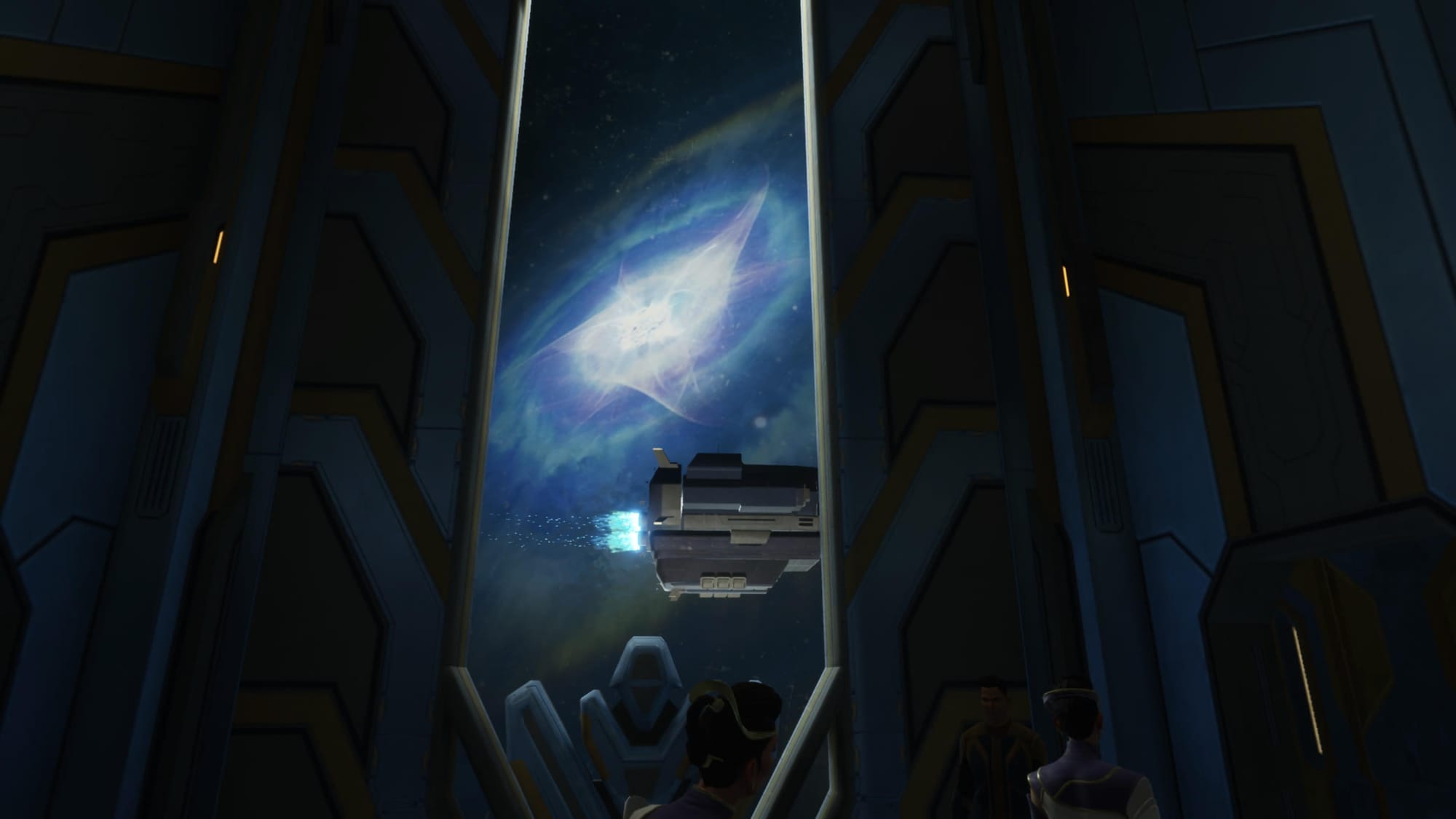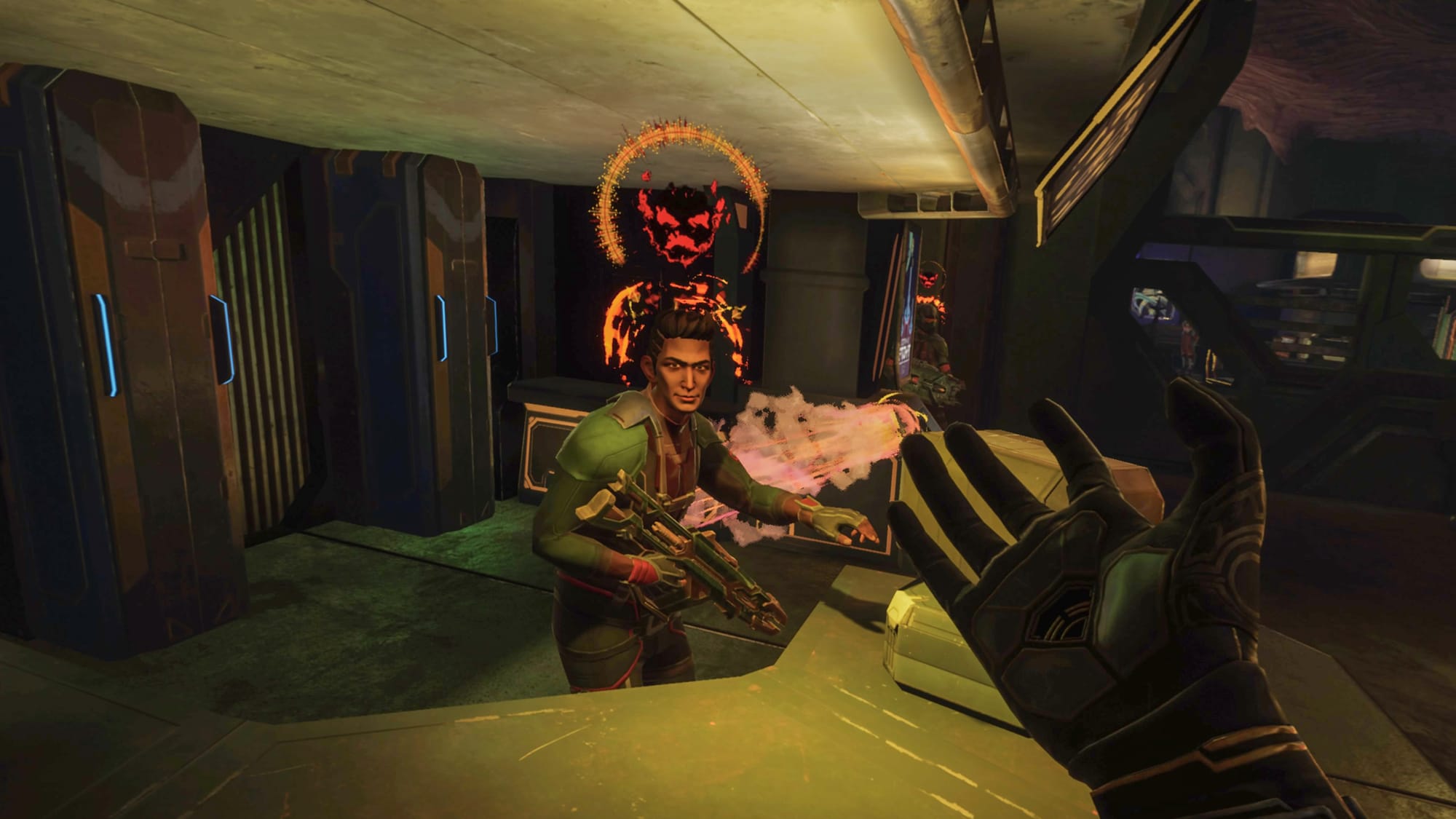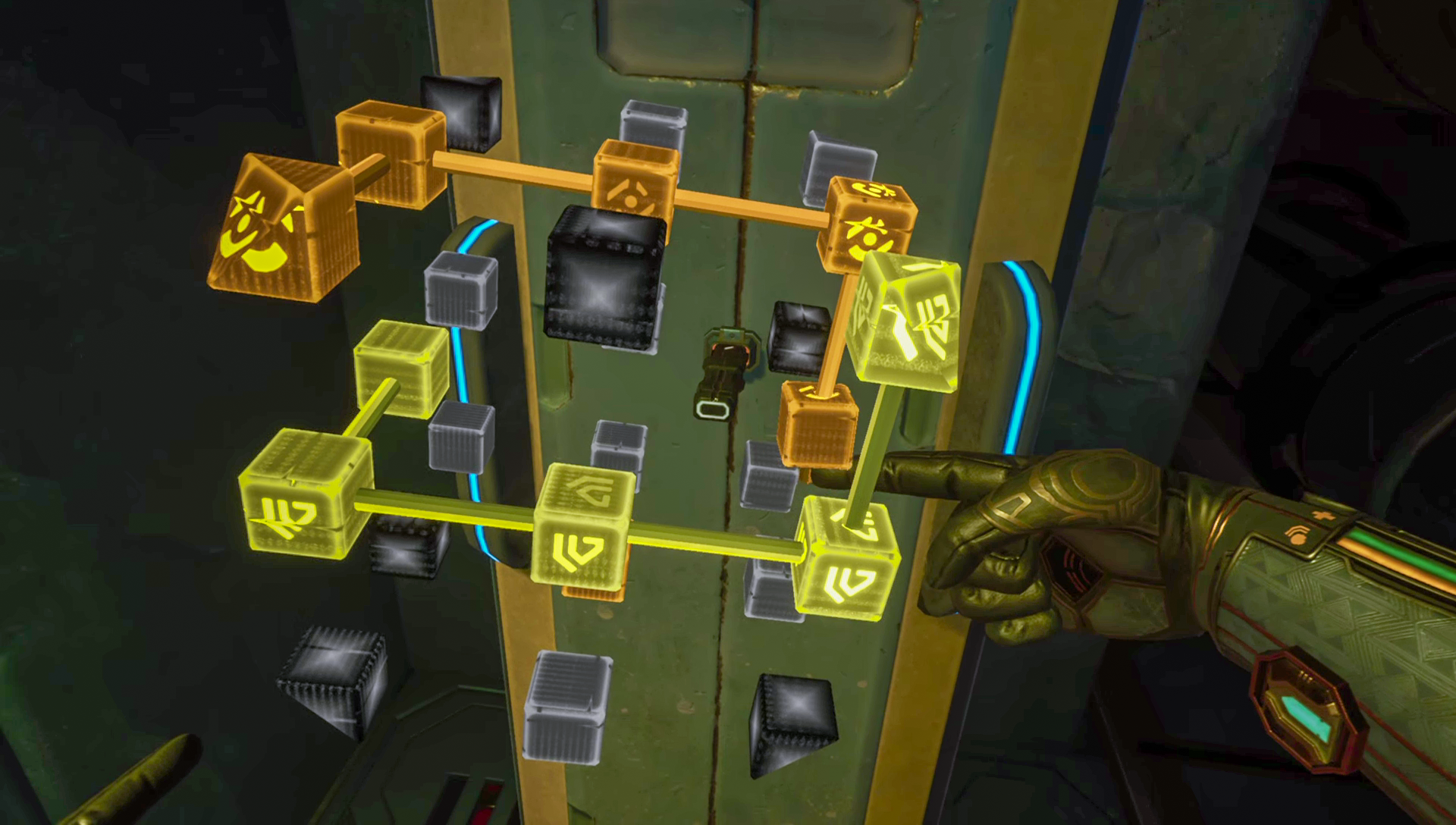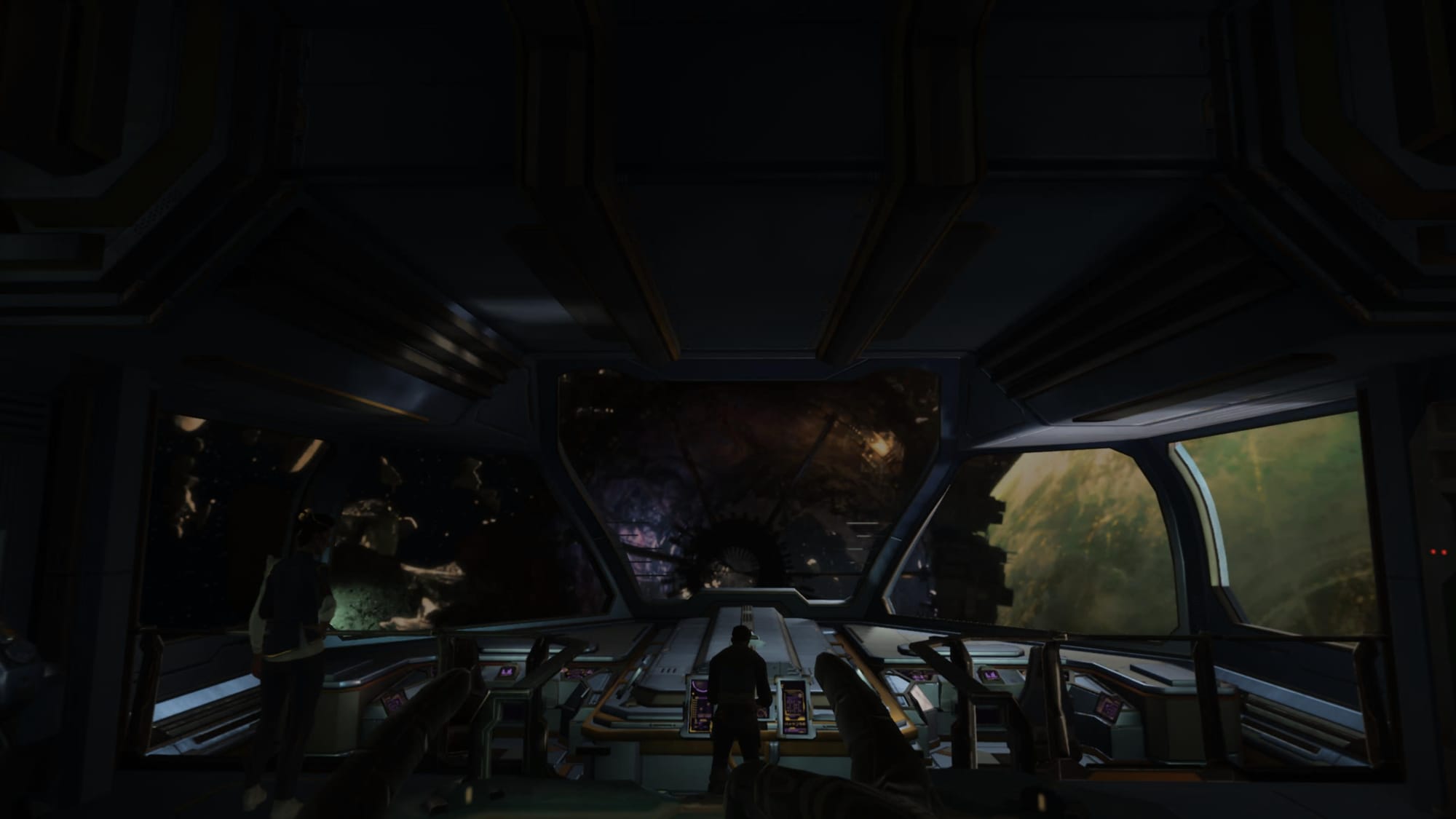One of VR’s recurring misconceptions is that it’s hard to find narrative-driven games that tell compelling stories. If you spend a few minutes searching a platform’s catalog, you might find the vast majority of games focus on one novel idea, an interesting twist on a VR-related mechanic, or a simple premise that encourages replayability.
Journey to Foundation introduces itself as an adventure game that emphasizes player choice and interesting twists based on your actions along the way. Based on Isaac Asimov’s sci-fi book series, you’re thrust into an intergalactic conflict through the eyes of Ward, a character who can make use of mental abilities during both conversations and enemy encounters.
It’s an ambitious premise that kept me invested during this seven-hour journey. In practice, however, many of the initially enticing mechanics fall flat, while the presentation isn’t what you would expect from a late 2023 game. It doesn’t take long to notice that developer Archiact Interactive chose to prioritize the story and the characters that inhabit it. This, for better or worse, is the dominant strength of Journey to Foundation.

Told over the span of six chapters, you navigate linear spaces — from ship interiors to caves and outposts across multiple planets — while talking to characters, solving fairly simple puzzles, and engaging in the occasional gunfight. It’s a simple structure that at no point attempts to flaunt something it isn’t.
For starters, objectives involve going from point A to B with little variation. Most areas are quite small, which means that if your current task leads you to ask people for information about a character or a keycode, you’re almost always presented with a room with one or two NPCs to talk to.
There isn’t much exploration to be carried out, either. You can find small devices with text blurbs or voice recordings that often provide context on people or the universe the game takes place in, but for the most part, I only sought them out when I needed some additional info to tackle an objective.
At no point did I feel stuck playing Journey to Foundation, although this seems deliberate. You have a compass on your left wrist that always marks the path forward. Puzzles, for the most part, are quite simplistic. Similarly to the NPCs example, the items you need are usually nearby. You might need to open a locker or listen to a voice recording to get to them, but that’s the biggest obstacle present. It’s during these moments that the interactivity with your digital hands shines the most, with different variations that aren’t exactly novel, but add to the overall immersion. Over time, however, they become formulaic.

Thankfully, the story makes it easy to look past some of these shortcomings. Previous knowledge of Isaac Asimov’s books isn’t necessary, although the lore exposition can be a bit much during the first hour or two. The focus on characters, as well as your conversations with them, carries Journey to the Foundation forward.
NPCs make for a solid presentation — with an art style akin to The Walking Dead: Saints & Sinners games — thanks to excellent voice acting and animations. It also helps that Ward also has a voice, making your back-and-forth chatter more organic. All of these elements are key since conversations are the bread and butter of the story. You always have talking points available, as well as the occasional “questions” option to expand more on a list of topics if you wish. Where Journey of Foundation’s conversations get interesting is when your decisions come into play.
Without spoiling any major story beats, Ward is part of an organization that, as you slowly learn during the campaign, isn’t as stable as it seems from the outside. A few key characters you come across present an alternative, and your organization tasks you with infiltrating them. From that point on, your actions can progressively favor one or the other, shaping the story and the eventual series of outcomes.

If you’ve learned a key piece of information before chatting with someone, that option will become available to influence and steer the conversation in your favor. If anything else fails, you can use your mental powers to detect the current emotion of the NPC you’re talking to, which usually leads to another dialogue option. You can also suppress certain moods, like fear, to get the result you need and continue with your objective.
Now, while the decisions do matter in both the short and long run, the mental powers becomes gimmicky fast. The mechanic doesn’t have that much depth, and it’s mostly a means to an end. If you’re stuck, you probably need to scan the order person until you get the desired dialogue option, and then move on to the next task. As I mentioned earlier, these abilities are also used during combat to take down enemies from afar or distract them so you can sneak past an area undetected. In most cases, however, it was easier to just draw my gun and take care of foes upfront — even if gunfights are never that exciting.
At times, my annoyances with Journey to Foundation got in the way of the experience. Environments can be quite dull, and the low-res backgrounds snap you out of any semblance of feeling in outer space in a second. A specific puzzle type, which has you connecting nodes in a cube-shaped floating structure, often got stuck in my hands, forcing me to restart the sequence altogether or stand still until it unstuck itself. It all adds to frustration, especially considering it’s a fairly recent VR title.

Journey to Foundation is a fairly slow-paced game most of the time, so you should be able to play it for long periods even without extensive VR experience. If you’re finding it hard to navigate, there are options to choose your dominant hand, adjust your height and holster position, enable or disable vignette, pick artificial stick-based locomotion (based on either your hand or your head) or teleportation movement, as well as either snap or smooth camera rotations.
Yet, I can’t say I wasn’t rewarded for sticking along regardless of my complaints. It was surprising to be able to de-escalate a prisoner to the point of offering them a deal, only to find out the deal wasn’t exactly signed off, and that I could keep them in the cell if I wanted to. I chose to keep my word, regardless of the character’s past crimes, and give them a second chance. Later on, a decision I made on a whim had an immediate negative reaction from one of the factions, creating ripple effects that were exciting to witness unfold.
Journey to Foundation – Final Verdict
Journey to Foundation tells a compelling story with no shortage of ambition in its methods to make you a part of it, ultimately shaping its outcome. This doesn’t always come together, and many of your actions in between make the experience feel like a time capsule of a bygone VR era in which studios still experimented with this space. That period might be in the past now, but in a time where many VR games continue to bet on spectacle and feel rather than worlds and characters leaving a mark, I’m glad that Archiact committed to the premise’s strengths from the beginning.

UploadVR uses a 5-Star rating system for our game reviews – you can read a breakdown of each star rating in our review guidelines.
- SEO Powered Content & PR Distribution. Get Amplified Today.
- PlatoData.Network Vertical Generative Ai. Empower Yourself. Access Here.
- PlatoAiStream. Web3 Intelligence. Knowledge Amplified. Access Here.
- PlatoESG. Carbon, CleanTech, Energy, Environment, Solar, Waste Management. Access Here.
- PlatoHealth. Biotech and Clinical Trials Intelligence. Access Here.
- Source: https://www.uploadvr.com/journey-to-foundation-review/
- :has
- :is
- :where
- 10
- 2000
- 2023
- 35%
- 41
- 7
- 8
- a
- abilities
- Able
- About
- across
- acting
- actions
- add
- Additional
- Adds
- adjust
- Adventure
- afar
- akin
- All
- almost
- along
- also
- alt
- alternative
- Although
- altogether
- always
- ambition
- ambitious
- an
- and
- animations
- Another
- any
- anything
- ARE
- AREA
- areas
- aren
- Art
- artificial
- AS
- ask
- At
- Attempts
- available
- backgrounds
- based
- BE
- beats
- become
- becomes
- before
- Beginning
- Bet
- Better
- between
- Biggest
- Bit
- book
- Books
- both
- Bread
- Breakdown
- but
- camera
- Campaign
- CAN
- care
- carried
- cases
- catalog
- cell
- certain
- Chance
- chapters
- character
- characters
- chatting
- choice
- Choose
- chose
- Close
- COM
- combat
- come
- committed
- Compass
- compelling
- compelling story
- complaints
- conducted
- conflict
- Connecting
- considering
- context
- continue
- Conversation
- conversations
- could
- Creating
- Crimes
- Current
- dead
- deal
- decision
- decisions
- depth
- desired
- detect
- Developer
- Devices
- dialogue
- DID
- different
- digital
- doesn
- dominant
- down
- draw
- during
- each
- Earlier
- easier
- easy
- effects
- either
- elements
- else
- emotion
- emphasizes
- enable
- encourages
- end
- enemies
- engaging
- enticing
- environments
- Era
- especially
- Even
- eventual
- exactly
- example
- excellent
- exciting
- Expand
- expect
- experience
- exploration
- extensive
- Eyes
- factions
- fails
- fairly
- Fall
- FAST
- favor
- fear
- feel
- feeling
- few
- final
- Find
- finding
- First
- flat
- floating
- Focus
- For
- forcing
- Forward
- Foundation
- from
- frustration
- game
- Games
- get
- Give
- going
- got
- had
- hand
- Hands
- Hard
- Have
- head
- height
- helps
- hour
- However
- HTTPS
- i
- idea
- if
- immediate
- immersion
- in
- influence
- info
- information
- initially
- interactive
- interactivity
- interesting
- interiors
- into
- Introduces
- invested
- involve
- isn
- IT
- items
- ITS
- itself
- journey
- jpg
- june
- just
- Keep
- kept
- Key
- knowledge
- Late
- later
- Leads
- LEARN
- learned
- leaving
- left
- like
- linear
- List
- listen
- little
- Locker
- Long
- Look
- looking
- made
- major
- Majority
- make
- MAKES
- Making
- many
- mark
- Matter
- me
- means
- mechanics
- mental
- mentioned
- Meta
- methods
- might
- Minutes
- misconceptions
- Moments
- more
- most
- mostly
- move
- movement
- much
- multiple
- my
- Navigate
- necessary
- Need
- needed
- negative
- never
- next
- no
- nodes
- Notice..
- novel
- now
- objective
- objectives
- obstacle
- occasional
- of
- off
- offering
- often
- on
- ONE
- only
- open
- Option
- Options
- or
- order
- organic
- organization
- Other
- our
- out
- Outcome
- outcomes
- outer space
- outside
- over
- overall
- part
- past
- path
- PC
- pc vr
- People
- period
- periods
- person
- pick
- Pico
- piece
- Place
- Planets
- platform
- plato
- Plato Data Intelligence
- PlatoData
- Play
- player
- playing
- playstation
- Point
- points
- position
- powers
- practice
- present
- presentation
- presented
- previous
- Prioritize
- probably
- progressively
- provide
- PSVR
- PSVR 2
- puzzle
- Puzzles
- quest
- Questions
- quite
- rather
- rating
- RE
- reaction
- Read
- recent
- recording
- recurring
- Regardless
- result
- review
- Reviews
- rewarded
- Ripple
- Room
- Run
- s
- say
- scan
- sci-fi
- searching
- Second
- seems
- Sequence
- Series
- shaping
- shines
- SHIP
- Short
- shortage
- shortcomings
- should
- Shows
- signed
- Similarly
- Simple
- simplistic
- since
- SIX
- Slowly
- small
- smooth
- Snap
- sneak
- So
- solid
- Solving
- some
- Someone
- something
- sought
- Space
- spaces
- span
- speaking
- specific
- spend
- stable
- stand
- Star
- starters
- steer
- sticking
- Still
- Stories
- Story
- story-driven
- strength
- strengths
- structure
- studios
- style
- surprising
- system
- tackle
- Take
- takes
- Talk
- talking
- Task
- tasks
- tell
- tells
- text
- than
- Thanks
- that
- The
- Them
- then
- There.
- These
- they
- this
- Through
- thrust
- time
- times
- Title
- to
- together
- Topics
- twist
- twists
- two
- type
- Ultimately
- Universe
- until
- UploadVR
- use
- used
- uses
- usually
- variations
- Vast
- Ve
- Voice
- vr
- VR Experience
- VR Games
- walking
- wanted
- was
- wasn
- Way..
- WELL
- were
- What
- when
- which
- while
- WHO
- will
- wish
- with
- without
- witness
- Word
- world’s
- worse
- would
- wrist
- You
- Your
- zephyrnet













